Upcoming Events:
- VCF South West - June 14 - 16, Davidson-Gundy Alumni Center at University of Texas at Dallas
- VCF West - Aug 2 - 3, Computer History Museum, Mountain View, CA
- VCF Midwest - Sept 7 - 8 2024, Schaumburg, IL
- VCF SoCal - Mid February 2025, Location TBD, Southern CA
- VCF East - April 2025, Infoage Museum, Wall NJ
-
Please review our updated Terms and Rules here
You are using an out of date browser. It may not display this or other websites correctly.
You should upgrade or use an alternative browser.
You should upgrade or use an alternative browser.
Hyperventilating - Just brought home PC 5150 in original boxes from original owner
- Thread starter Anonymous Freak
- Start date
Anonymous Freak
Veteran Member
Yeah, silly forum software not obeying the EXIF rotation data!
Anonymous Freak
Veteran Member
And in playing Kings Quest II, and comparing CGA composite to PCjr native support, CGA composite looks better!
As a kid, we only had a TTL CGA monitor, and I didn't even know about CGA composite mode until I no longer had a CGA system. So this is my first experience seeing actual CGA composite output.
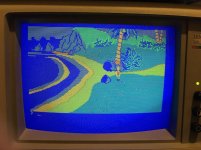
CGA in TTL mode (with KQ set to proper "RGB" mode)
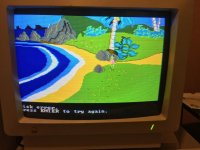
CGA in composite mode (with KQ set to proper composite mode.)
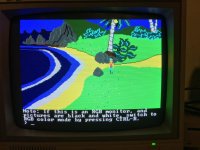
PCjr native.
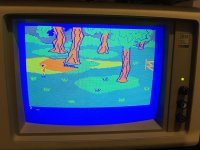
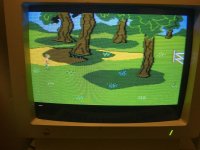
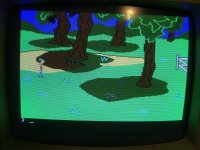
The greens just look so much nicer than the PCjr greens. The browns more pleasant. Yeah, it's a lot sharper on the PCjr thanks to being a "real computer signal", but the colors are just so much nicer!
As a kid, we only had a TTL CGA monitor, and I didn't even know about CGA composite mode until I no longer had a CGA system. So this is my first experience seeing actual CGA composite output.

CGA in TTL mode (with KQ set to proper "RGB" mode)

CGA in composite mode (with KQ set to proper composite mode.)

PCjr native.



The greens just look so much nicer than the PCjr greens. The browns more pleasant. Yeah, it's a lot sharper on the PCjr thanks to being a "real computer signal", but the colors are just so much nicer!
It never even crossed my mind that CGA could be decent looking until recent years. Yeah, I had CGA cards with composite out. But, coming from Commodores first, I knew better. I mean, RGB monitors /always/ had better quality than composite. Of course, I had Apples even before that. But back then, it wasn't proper to connect a colour monitor to an Apple ][. The only people that did that were the ones that couldn't afford a green data monitor for serious use.
Anonymous Freak
Veteran Member
Oh, and after doing some digging, the APL ROM is just a "font replacement" ROM. It contains both the standard IBM ROM font, as well as an APL font for use when running their APL interpreter. (Which is *NOT* in ROM, it's still just BASIC on ROM; you need to run the DOS program for it.)
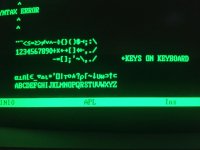
First row is shifted numbers and symbol keys
Second row is unshifted numbers and symbol keys
Third row is (best I can do with the APL font!) what symbols are actually on the keys (since it may not be obvious.)
(this line intentionally left blank)
Fourth row is shifted letters, in alphabetical order
Fifth row is unshifted letters (which is the standard set.)

First row is shifted numbers and symbol keys
Second row is unshifted numbers and symbol keys
Third row is (best I can do with the APL font!) what symbols are actually on the keys (since it may not be obvious.)
(this line intentionally left blank)
Fourth row is shifted letters, in alphabetical order
Fifth row is unshifted letters (which is the standard set.)
framer
Veteran Member
Love the mouse w/green ears, It took me years to get my hands on one.
Am I understanding you have no 360K floppies or DOS Operating System on a 360K floppy?
framer
Am I understanding you have no 360K floppies or DOS Operating System on a 360K floppy?
framer
billdeg
Technician
When this forum first started ibm pc's were too new for some board members. Funny.
Corey986
Administrator
When this forum first started ibm pc's were too new for some board members. Funny.
Still is to some ;-)
lyonadmiral
Veteran Member
Standard keyboard, not APL.
Those suggesting I just put an EXE on a disk and run it - that's the problem, I have no way of getting anything on to a 360K floppy at the moment. I wish there was an "ADT Pro" like app for old PCs. Something where you just enter a couple commands in the built-in BASIC to "bootstrap" booting over serial or cassette port. Ironically, I do have a SCSI dual-5.25"-floppy (one 360k and one 1.2M drive) external device that came with a Mac I bought recently, but it's missing its power cord! (And of course uses a nonstandard power connector.)
I've been and have advocated for something like that for a long time, a program you could pull into the ROM BASIC so you could make floppies for those of us who did not have tweener systems or friends willing to send some "bootstrap" floppies to get us started.
I guess because of the work involved it was not feasible.
Anonymous Freak
Veteran Member
I've been and have advocated for something like that for a long time, a program you could pull into the ROM BASIC so you could make floppies for those of us who did not have tweener systems or friends willing to send some "bootstrap" floppies to get us started.
I guess because of the work involved it was not feasible.
Which is too bad, because it exists for Apples, Amigas, and most other similar-vintage computers.
Chuck(G)
25k Member
Oh, I think it's possible, but how common is ROM BASIC? Certainly not on many clones.
lyonadmiral
Veteran Member
Oh, I think it's possible, but how common is ROM BASIC? Certainly not on many clones.
Clones, I don't need no stinking clones.
Last edited:
Anonymous Freak
Veteran Member
How big is the market? It has to work on every machine which someone who doesn't have access to another method has.
ADTPro is a Java app, works on just about everything.
krebizfan
Veteran Member
ADTPro is a Java app, works on just about everything.
It seems possible to create a similar application for the IBM PC but is it really worth spending the probable 6+ months on developing it instead of convincing people to either buy a proper tweener or temporarily install a 3.5" floppy drive if the BIOS is new enough to boot from that?
ADTPro is a Java app, works on just about everything.
I meant the target machine. But Java sure doesn't even run on everything, either.
The target machine side of the software, in this case, has to be able to run on every configuration of PC, PC/XT, PC/AT, and all the various clones of each of those, plus probably the PS/2 series machines.
It's much less difficult to do this with the Apple ][ series.
The thing is though, the Apple software benefits the vast majority of Apple ][ owners. "PC" software world only benefit a very small minority of those owners, at this point. (At least, I think so, but I could be wrong.) The proof is in the pudding: there hasn't been enough demand for someone to do it.
Anonymous Freak
Veteran Member
Well, the PS/2 series should be safe, since they all have 3.5" floppy drives. Even the earliest/lowest-end ones. And USB 3.5" drives are still easy to come by.
I would say that something that works with the onboard BASIC of the PC, XT, and AT series would be the most useful.
The major problem with a "tweener" system is that it requires getting a working 360kB 5.25" drive that works with a modern enough system. I have had a hell of a time finding a good 5.25" drive. That's my major problem with making floppies for my 5150. I have one of the Teac "dual drives" (3.5" and 5.25" in one 5.25" bay,) but the 5.25" side stopped working.
I would say that something that works with the onboard BASIC of the PC, XT, and AT series would be the most useful.
The major problem with a "tweener" system is that it requires getting a working 360kB 5.25" drive that works with a modern enough system. I have had a hell of a time finding a good 5.25" drive. That's my major problem with making floppies for my 5150. I have one of the Teac "dual drives" (3.5" and 5.25" in one 5.25" bay,) but the 5.25" side stopped working.
Scali
Veteran Member
I think the big problem with PCs is that their BIOSes are pretty much useless.
Real IBMs at least have BASIC, so you can boot to that, and then enter a simple program that can read from the serial port (although of course not all PCs have a serial port, so there is that), so you can transfer data from another system. You might be able to work your way up to a bootable floppy from there.
But clones lack BASIC, so if you don't have a bootable floppy, you basically have nothing. There's no way to interact with the machine at all.
The way I bootstrapped my 5.25" system is by temporarily connecting a 3.5" drive (borrowed from another system) as first drive, and 5.25" as second drive. I then wrote a bootable DOS disk from a modern system via a USB drive. I booted the machine on 3.5". Then made a 5.25" boot disk on the machine.
I also copied the FastLynx slave program, so I could transfer files via serial cable.
After that I removed the 3.5" drive again, and the system could now boot from the 5.25" drive, and I could send data to it via the serial cable from the modern system.
I currently have two PCs with serial port, harddrive and 5.25" 360k. So I can easily transfer disk images from a modern PC and write them on a 5.25" 360k floppy now.
Real IBMs at least have BASIC, so you can boot to that, and then enter a simple program that can read from the serial port (although of course not all PCs have a serial port, so there is that), so you can transfer data from another system. You might be able to work your way up to a bootable floppy from there.
But clones lack BASIC, so if you don't have a bootable floppy, you basically have nothing. There's no way to interact with the machine at all.
The way I bootstrapped my 5.25" system is by temporarily connecting a 3.5" drive (borrowed from another system) as first drive, and 5.25" as second drive. I then wrote a bootable DOS disk from a modern system via a USB drive. I booted the machine on 3.5". Then made a 5.25" boot disk on the machine.
I also copied the FastLynx slave program, so I could transfer files via serial cable.
After that I removed the 3.5" drive again, and the system could now boot from the 5.25" drive, and I could send data to it via the serial cable from the modern system.
I currently have two PCs with serial port, harddrive and 5.25" 360k. So I can easily transfer disk images from a modern PC and write them on a 5.25" 360k floppy now.
Stone
10k Member
I have some 5¼" 360k drives if you're looking for one.The major problem with a "tweener" system is that it requires getting a working 360kB 5.25" drive that works with a modern enough system. I have had a hell of a time finding a good 5.25" drive. That's my major problem with making floppies for my 5150. I have one of the Teac "dual drives" (3.5" and 5.25" in one 5.25" bay,) but the 5.25" side stopped working.
Al Hartman
Veteran Member
Well...
The BIOS used with the XT-IDE cards allow booting over a serial cable to another system, and mounting disk images from them. Also, LapLink allows installation over a serial cable to install the client software.
I also bought a parallel port 3.5" backpack drive, and thanks to a member here, got the software from him to get it running on my 5150 PC.
So, that got me up and running.
Even better was building one of Sergey's Floppy/Serial controllers so I could use any kind of floppy drive (5.25" or 3.5", even 8" with an adapter). It was easy to build, works great, and even lets me read/write single density TRS-80 Disks.
The BIOS used with the XT-IDE cards allow booting over a serial cable to another system, and mounting disk images from them. Also, LapLink allows installation over a serial cable to install the client software.
I also bought a parallel port 3.5" backpack drive, and thanks to a member here, got the software from him to get it running on my 5150 PC.
So, that got me up and running.
Even better was building one of Sergey's Floppy/Serial controllers so I could use any kind of floppy drive (5.25" or 3.5", even 8" with an adapter). It was easy to build, works great, and even lets me read/write single density TRS-80 Disks.
